PATH: Boat Building & Refitting » Boat Equipment » Propulsion » Engines »
PAGE CONTENTS: (click ⇒ to go to each section on this page)
⇒ Topic Treatment: Introduction, Overview, Background, Details, Directories,+.
⇒ ^ Related Resources: EAB Topics w/Directories, Vendors, Products: Media: Books, Websites,+.
⇒ Visit EAB's FEATURED ARTICLES Home Page to preview the vast scope of our website.
⇒ This Month's Top 20 Most Popular Articles on our EAB website.
⇒ Layout of the EverythingAboutBoats.org Website's Pages: Page Types, Contents, Topics,+.
⇒ What our nonprofit Anchors Aweigh Academy and its EAB website have accomplished.
⇒ Members must SIGN IN to gain access to Members Only areas of this website.
⇒ Become an Academy Member and gain access to additional pages and programs!
⇒ Comments: Submit To ⇒ Comments♥EverythingAboutBoats.org (Replace "♥" with "@").
“Open-Deck” vs “Full-Deck” Cylinder Block Designs
Typical diesel engine blocks have cast and machined “decks” that support the top of the cylinders and evenly squash the head gaskets against the heads. In addition, most small V8 diesel engines have at least 6 head bolts (some shared with neighboring cylinders) in a full circle pattern around the top of the cylinder to more evenly provide the necessary head tightness on the head gasket. Both of these features can be seen in the Caterpillar 3208 whose cylinder block shown directly below was produced with 18 head bolts per head and a “full deck” that naturally supports the top of each cylinder, preventing the cylinders from expanding and crushing the head gasket, and flexing and working against the head gasket, further damaging the head gasket.
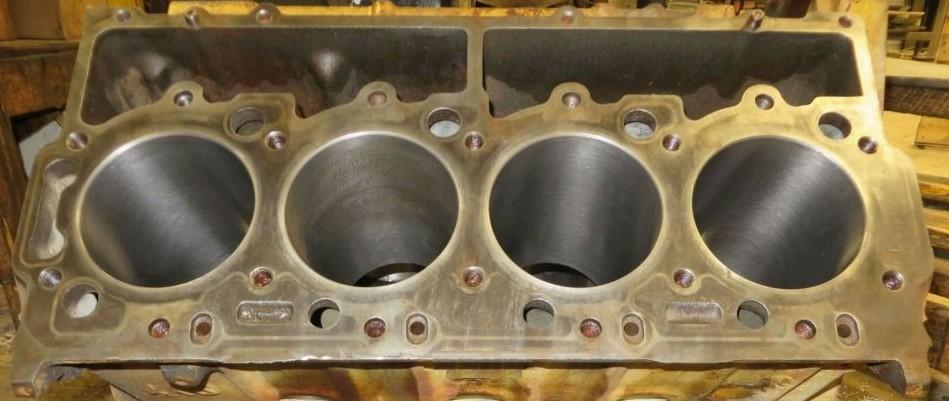
Caterpillar 3208 “Parent Bore” Cylinder Block with Full “Deck” and 18 Head Bolts per Head.
Unfortunately, the cheaper Detroit Diesel 8.2 engine block, as clearly illustrated in their brochure shown directly below, has neither the “full-deck” nor at least six head bolts per cylinder. The 8.2 has only 4 head bolts per cylinder and most of those head bolts are shared with neighboring cylinders for a total of ten head bolts for four cylinders (per head).
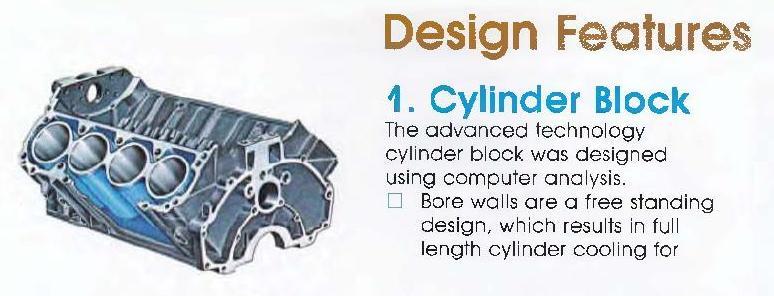
Detroit Diesel 8.2L Block with “Free Standing Cylinders” (Note the open space all around the joined (siamese) cylinders)
This brochure is available for viewing in its entirety by Academy Members as a PDF from our Academy eLibrary – Click Here – where all can see a scathing review of this brochure.
According to the above brochure, the Detroit Diesel 8.2 cylinder block was “designed using computer analysis” (Remember the adage “Garbage in, garbage out”), and was cast without the full head gasket mating surface (the “deck”) leaving the joined “Siamese” cylinders “free-standing”. The 8.2 head gasket mating surface is drastically reduced and consists of just the narrow top ends of the cylinders which consequently can provide only limited sealing surface which has proven to be seriously inadequate.
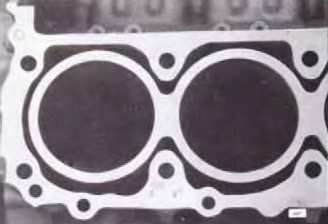
Detroit Diesel 8.2 “Open Deck” free standing Cylinders
Detroit Diesel advertised that the reason that they did this was to provide “full length cylinder cooling”, While this design does provide slightly more even cooling of the cylinders, the far more compelling reason to use this design was to leave the top of the cylinder casting open and accessible to allow a more precise locating of the mold (or die) during the casting process which allowed the block to be cast thinner and consequently lighter and cheaper as it did not require as much safety margin thickness for “mold slip”.
This “Open Deck free-standing” cylinder design is not new. Most die cast aluminum blocks are of this design including the ill-fated Chevrolet Vega engine block pictured directly below, which also suffered from frequent head gasket failures at least partly because of this “Open Deck” free-standing design.

Chevrolet Vega Engine Block with “Open Deck” design.
However, to be fair, some of the Vega’s head gasket problems stemmed from the block being cast entirely of aluminum which quickly expands far more then cast iron as it heats up. Since the cylinders ran at a higher temperature then the rest of the block, the cylinders expand more then the sides of the block and thus crush the head gasket against the head while the head is held against the block by the head bolts. And when the cylinders cooled, they would shrink and draw back away from the now crushed head gasket allowing it to leak and blow-out, especially if the engine was later put under heavy load when cold.
Efforts to press iron sleeves or liners into the aluminum Vega blocks has proven fruitless as the aluminum, now thinner and weaker after the boring which was needed to receive the liner, would expand more then the iron liner due to the heat at running temperature, allowing the liners to become loose in the aluminum block. Also, the reduced heat transfer from the liner often resulted in the liner overheating and developing hot spots leading to scoring of the pistons, rings and liner, and spot glazing of the liner.
Aluminum cylinder blocks cast with integral cast iron cylinder liners such as found in most outboard motors (see picture below where the cast-in iron liner can be seen surrounded by cast aluminum), suffer far less expansion then blocks cast entirely of aluminum like the Vega’s block. However when these Iron/aluminum blocks are overheated, the aluminum expands faster then the cast iron liner, often popping the aluminum loose from the cast iron liner making the block unusable due to its reduced ability to transfer heat from the iron liner to the aluminum before before being dissipated into the coolant. It should be noted that outboard motors with free standing cylinders are also prone to suffer blown head gaskets.
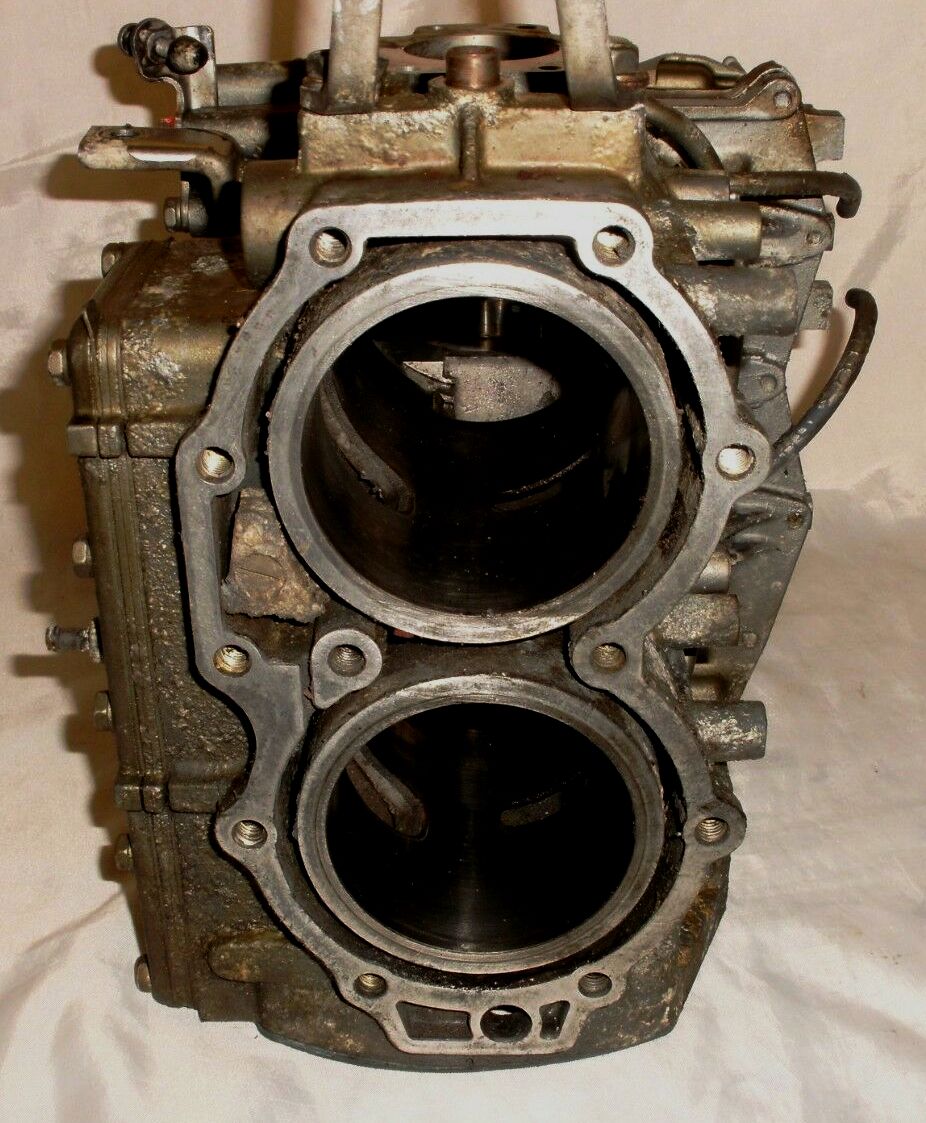
Yamaha 40hp outboard motor die cast aluminum cylinder block with integral cast-in iron liners
The Homelite/Bearcat 55hp 4-Cycle cylinder blocks were cast with integral heads eliminating the need for a head gasket. This design required that the pistons be installed and removed from the cylinders through the crankcase. For many years, Mercury Outboard 2-Cycle cylinder blocks were similarly cast with integral heads (shown below with the water jacket cover removed, exposing the top of the integral combustion chamber).
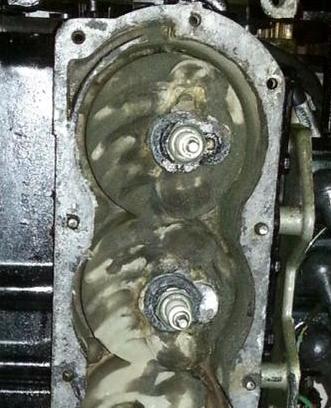
1985 Mercury Inline-6 outboard with water jacket cover removed showing integral cast-in block cylinder head.
In the case of the Detroit Diesel 8.2, besides the drastically reduced head gasket sealing surface and the cylinder expanding and crushing the head gasket, an even more destructive deficiency exists due to the “Open Deck” free-standing design (shown directly below). The cylinders lack any connection between the tops of the cylinders and the engine block. This connection would normally be provided by the “deck” which would support the top of each cylinder and prevent the cylinder from flexing and moving back and forth side-to-side and working against the head gasket when the engine is running especially at higher power output.
This process is illustrated in the 4-Stroke Cycle diagram below where the piston can be seen first pushing against the right side of the cylinder during the compression stroke (see first yellow arrow – to the left) and then pushing even harder against the left side of the cylinder during the power stroke (see second yellow arrow – to the right). This pushing force is of course due to the changing angle of the connecting rod to the crankshaft’s rod journal as the crankshaft turns. Without a full “deck” to support the tops of the cylinders, the cylinders are allowed to flex back-and-forth, moved by the side loads induced by the piston, destroying the head gasket. This damage occurs even more quickly when the engine is lugged.
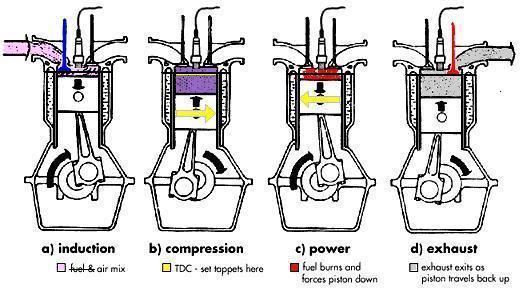
The Detroit Diesel 8.2L Service Manual #6SE421 describes in section 1.1 the procedure for checking the flatness of the top of the block with a straight edge after the head has been removed to determine if the block’s mating surface to the head (the “Firedeck”) is flat enough.
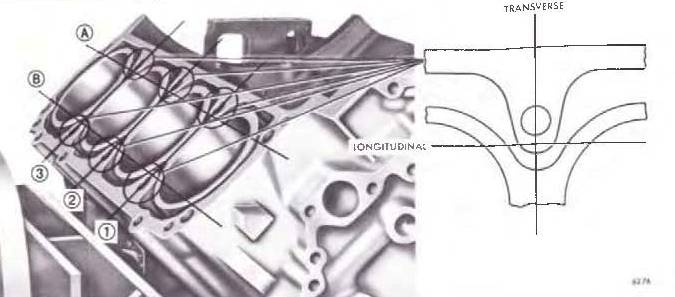
Detroit Diesel 8.2 Cylinder Block Flatness Check
Note that additional transverse locations were required by later revisions to this test procedure.

Checking the Cylinder Block’s “Firedeck” for Longitudinal Flatness Using a Straight Edge.
If the top surface varies by more then .07mm (0.003″) transversely or more then .17mm (0.007″) longitudinally, the block must be “rejected”. When checked, blocks from engines that had blown head gaskets were frequently found to be beyond these limits and therefore could not be reused, relegating them to the scrap heap. Amazingly, the cylinders in these blocks were often found to be slightly bent to one side (as illustrated below), undoubtedly by the force of the pistons during power strokes as illustrated by the yellow arrow above. These bent cylinders were sometimes found to have cracked at their base where they joined the block.

Straight Edge Test of Transverse Flatness
This “Open Deck free-standing” design makes the 8.2 engine prone to head gasket failures and the resulting internal damage (described later) which tends to be catastrophic. Operation of the 8.2 at flank (full) speed in marine service is not wise unless the propeller is “under-pitched”, allowing the engine to run more easily. This will also be discussed later in this article under “How to keep the 8.2 alive”.
Although GM reportedly considered producing the 8.2 with a “Full Deck” after production was moved to GM’s automotive division in Canada, this apparently never came to fruition.
+
⇒ Media Directory Under Development ⇐
| MEDIA TYPE: | RC |
| Title — Creators (Authors‚ Editors‚ Illustrators‚+) – Source (Publishers‚+) | RC |
| Product Documentation: | D |
| ΞTitleΞ – + (ΞNotesΞ) — ΞCreatorΞ – ΞSourceΞ | D |
| Books: | B |
| ΞTitleΞ – + (ΞNotesΞ) — ΞCreatorΞ – ΞSourceΞ | B |
| Magazines: | M |
| ΞTitleΞ – + (ΞNotesΞ) — ΞCreatorΞ – ΞSourceΞ | M |
| Videos: (Incl. Movies‚+) | V |
| ΞTitleΞ – + (ΞNotesΞ) — ΞCreatorΞ – ΞSourceΞ | V |
| Websites: | W |
| ΞTitleΞ – + (ΞNotesΞ) — ΞCreatorΞ – ΞSourceΞ | W |
Related Media
with Links to EAB's Media Overview and Creator Profile Pages
Media with Bold Titles are part of our Academy eLibrary!
Academy Members can view the Media by clicking on its Bold Title Link to go to its
EAB overview page and then scrolling down to the "Academy eLibrary" section for its link.
To help us alphabetize the media lists below, each leading grammatical
article ("The" - "A" - "An") has been moved to the end of the title.
DS = Data Source code
⇒ Media Directory Under Development ⇐
| MEDIA TYPE: | RC |
| Title — Creators (Authors‚ Editors‚ Illustrators‚+) – Source (Publishers‚+) | RC |
| Product Documentation: | D |
| ΞTitleΞ – + (ΞNotesΞ) — ΞCreatorΞ – ΞSourceΞ | D |
| Books: | B |
| ΞTitleΞ – + (ΞNotesΞ) — ΞCreatorΞ – ΞSourceΞ | B |
| Magazines: | M |
| ΞTitleΞ – + (ΞNotesΞ) — ΞCreatorΞ – ΞSourceΞ | M |
| Videos: (Incl. Movies‚+) | V |
| ΞTitleΞ – + (ΞNotesΞ) — ΞCreatorΞ – ΞSourceΞ | V |
| Websites: | W |
| ΞTitleΞ – + (ΞNotesΞ) — ΞCreatorΞ – ΞSourceΞ | W |
If any Media or Creators should be added to this list, please submit their info/links via email To:
Editor♥EverythingAboutBoats.org (Replace "♥" with "@")
NOT AN ACADEMY MEMBER?
CLICK HERE to discover how you can become a Member and gain FULL access to
thousands of expanded pages and dozens of excellent programs including our eLibrary!
CLICK HERE to view ALL the books, magazines, videos, etc. in our Academy eLibrary.
Media are also listed by category on the Topic Pages found on the Right Sidebar ⇒
CLICK HERE to donate any books, magazines, manuals, or videos, etc. to our Library.
02 – BOAT BUILDING, OUTFITTING, REFITTING & REPAIR: (Incl. DIY).
02.01 – Boat Designing Schools:
02.02 – Boat Designers: (Naval Architects, Boat Plans, Kits,+).
02.03 – Statutes & Standards: (Vessel & Equipment Requirements,+).
02.03.01 – Marine Laws & Regulations: (CAN, GBR, USA,+).
02.03.02 – Industry Standards: (ISO, IMO, ABYC, NFPA,+).
02.03.03 – Classification Societies: (ABS, LR, DNV<GL, BV, RINA,+).
02.04 – Boat Building & Refitting Tools,+: (Vendors, Specs, Manuals, Recalls,+).
02.05 – Boat Materials: (Qualities, Vendors, Specs, Manuals, Recalls,+).
02.05.01 – Wood: (Species, Rot; Carvel, Clinker/Lapstrake, Veneer/Plywood, Cold Molded,+).
02.05.02 – Metal: Iron, Steel, Aluminum, Copper,+. (Strengths, Weaknesses, Corrosion,+).
02.05.03 – Ferrocement: (Strengths, Weaknesses, Corrosion,+).
02.05.04 – FRP & GRP Composites: Fiberglass, Carbon Fiber,+. (Strengths, Weaknesses,+).
02.06 – Boat Equipment: (Vendors, Specs, Manuals, Reviews, Recalls,+).
02.06.01 – Steering & Thrusters: (Mechanical, Electric, Hydraulic,+).
02.06.02 – Stabilizers & Trim Plates: (Mechanical, Electric, Hydraulic,+).
02.06.03 – Dewatering Devices: (Bailers, Bilge Pumps,+).
02.06.04 – Galvanic Corrosion Protection: (Active, Anodes,+).
02.06.05 – Hull Penetrations & Openings: (Thru-Hulls, Scuttles, Skylights, Hatches,+).
02.06.06 – Deck Hardware & Equipment: (Cleats, Railings,+).
02.06.06.01 – Ground Tackle: (Anchors, Rodes, Chocks, Winches,+).
02.06.06.02 – Commercial Fishing Gear: (Pots, Nets, Lines, Winches, Reels, Rods,+).
02.06.07 – Rigging: (Rig Types, Standing Rigging, Running Rigging, Vendors, Riggers,+).
02.06.07.01 – Sails: (Sail Types, Aerodynamics, Vendors, Sailmakers,+).
02.06.08 – Propulsion Machinery: (Types, Configurations, Features, Control Systems,+).
02.06.08.01 – Engines: (Systems, Manufacturers, Marinizers, Resellers,+).
02.06.08.01.01 – Engine Mechanical (Pistons, Rods, Crankshafts, Cylinders, Heads, Valves,+).
02.06.08.01.02 – Engine Lubrication (Splash, Forced, Oil, Filtration, Additives, Oil Analysis,+).
02.06.08.01.03 – Engine Aspiration & Fuel (Natural & Charged; Gasoline, Diesel, Bunker, NG,+).
02.06.08.01.04 – Engine Electrical (Cranking, Charging, Ignition, Instrumentation, Electronics,+).
02.06.08.01.05 – Engine Cooling (Air, Liquid: Raw Water, Fresh Water w/Keel Coolers, Heat Exchangers,+).
02.06.08.01.06 – Engine Exhaust (Dry, Wet w/Separators,+).
02.06.08.01.07 – Engine Mounting (Hard, Soft,+).
02.06.08.02 – Engine-to-Marine Gear Interfaces: (SAE Specs, Damper Plates, Jackshafts,+).
02.06.08.03 – Marine Gears: (Reversing, Reduction; Mechanical, Hydraulic).
02.06.08.04 – Shafting: (Propshafts, Couplings, Seals, Bearings, Struts, Keys, Nuts,+).
02.06.08.05 – Propellers: (Types, Materials,+).
02.06.09 – Electrical Systems: DC & AC (Direct Current: Batteries, Solar,+; Alternating Current,+).
02.06.09.01 – Auxiliary Generators: (Diesel, Gasoline, Natural Gas,+).
02.06.09.02 – DC-to-AC Inverters:
02.06.10 – Navigation & Communication Systems: (Charting, GPS. Radar; WX, SAT, HF, VHF,+)
02.06.11 – Safety Equipment: (Life Rafts, PFDs, Firefighting Eq., Alarms, Medical Kits,+).
02.06.12 – Domestic Systems:
02.06.12.01 – LPG & CNG Systems:
02.06.12.02 – Cabin Heating & Cooling: (Heaters, Heat Pumps; Air Conditioning,+)
02.06.12.03 – Galley Appliances: (Refrigeration, Galley Stoves,+).
02.06.12.04 – Water & Waste Systems: (Tanks, Water Makers, Pumps, Plumbing,+)
02.06.12.05 – Trash Disposal:
02.06.12.06 – Furnishings: (Cabinetry, furniture, Coverings, Entertainment, Weather,+).
02.06.13 – Personal Equipment:
02.06.13.01 – Diving: (Commercial & Sport).
02.06.13.02 – Fishing: (Sport).
02.06.13.03 – Racing: (Sail, Offshore Power, Powerboat, Hydroplane,+).
02.06.13.04 – Sailing: (Foul Weather Gear, Safety Harnesses,+).
02.06.13.05 – Watersports: (Surfing, Skiing, Boarding, Tubing,+).
02.06.14 – Boat Tenders:
02.06.15 – Boat Trailers: (Bunk, Roller,+)
02.07 – Marine Suppliers: (CAN, GBR, USA,+). (National Chains, Local,+)
02.08 – Boat Builders: (A∼Z) (w/Vessel Types, Locale & Years Active)
02.09 – Boat Refitters: (CAN, GBR, USA,+) (Shipyards, Boatyards, Riggers, Repair Shops,+).
02.10 – Boat Building, Outfitting, Refitting & Repair Schools: (Incl. DIY).
02.11 – DIY Boat Building, Outfitting, Refitting & Repair: (Maintenance‚ Troubleshooting‚+).
15 – DO-IT-YOURSELF (DIY):
15.01 – DIY Boat Building, Outfitting, Refitting & Repair: (Incl. Maintenance & Fault Finding).
15.02 – DIY Boat Sales: (Buyers & Sellers).
15.03 – DIY Boat Inspections: (Pre-Survey, Pre-Purchase, Pre-Sale, Pre-Voyage, Sea Trials,+).
15.04 – DIY Schools & Classes: (Boat Building, Refitting, Inspection, Troubleshooting, Repair,+).
16 – MEDIA w/Creator Directory: (Authors, Editors, Publishers,+) + Academy eLibrary.
16.01 – Documentation: (Catalogs, Ads, SpecSheets, Manuals, TechVids, Bulletins, Recalls‚+).
16.02 – Books: (Bound, eBooks,+).
16.03 – Magazines: (Incl. Back Issues, Articles,+).
16.04 – Videos: (How-to-Tutorials, Documentaries, Travelogues, Movies,+).
16.05 – Websites: (Incl. Articles, Forum Posts, Tech Tips, Tech Notes, Social Media,+).
EVERYTHING ON THIS PAGE OK?
If there is anything on this webpage that needs fixing, please let us know via email To:
Editor♥EverythingAboutBoats.org (Replace "♥" with "@")
THIS ARTICLE IS STILL EVOLVING!
The page may contain rough drafts that include raw source materials.

Visit our FEATURED ARTICLES Home Page
to see examples of our website's comprehensive contents!
Thanks to our amazing contributors for the steady flow of articles, and to our dedicated all-volunteer staff who sort, polish and format them, everyday we get a little bit closer to our goal of
Everything About Boats. If you would like to submit an article,
See Submitting Articles.
— TOP 20 MOST POPULAR ARTICLES —
Detroit Diesel 8.2 Liter “Fuel Pincher” V8 Engine
Cummins V-555 & VT-555 “Triple-Nickel” V8 Diesel Engine
Lehman 120 (6D380) Diesel Engine (Ford 2704C & 2715E)
Ford Industrial Power Products Diesel Engines
How to Identify Ford Diesel Engines
Ford 2715E Diesel Engine
Lehman Mfg. Co.
Perkins Engines
Universal Atomic 4
Sears Boat Motors: Motorgo, Waterwitch, Elgin, etc.
Chrysler & Force Outboards
Eska Outboard Motors
Allison Transmission
ZF Friedrichshafen AG
Marine Surveyors by Country
American Marine Ltd (Grand Banks)
Boat Inspection (Types of Marine Surveys)
Boat Builders: (A∼Z) (w/Vessel Types, Locale & Years Active)
USCG NVIC 07-95 Guidance on Inspection, Repair and Maintenance of Wooden Hulls
American Boat and Yacht Counsel (ABYC)
Layout of the EverythingAboutBoats.org Website's Pages
— Types of Webpages —
This website consists almost entirely of 3 types of webpages as follows:
- TOPIC PAGES (See Main Topic Pages listed on Website Contents or the Right Sidebar) ⇒
- EXAMPLE: – WEBSITE CONTENTS w/Links to MAIN TOPIC & Subtopic Pages:
- EXAMPLE: 02 – BOAT BUILDING, OUTFITTING, REFITTING & REPAIR:
- EXAMPLE: 02.06 – Boat Equipment:
- EXAMPLE: 02.06.08 – Propulsion Machinery:
- EXAMPLE: 02.06.08.01 – Engines w/Directory of Vendors.
- VENDOR PAGES (Vendors of Products, Services, Events,+, Destinations & Media Creators)
- EXAMPLE: 02.06.08.01 – ^ Ford Industrial Power Products Diesel Engines.
- PRODUCT PAGES (Equipment, Events, Media: pDoc, Books, Magazines, Videos, Websites,+)
- EXAMPLE: 02.06.08.01 – ^ ^ Ford 2715E Diesel Engine.
- EXAMPLE: 02.06.08.01 – ^ ^ Ford OpManual - 2710 Range Diesel Engines.
- EXAMPLE: 02.06.08.01 – ^ ^ Ford Service Manual - 2700 & 2710 Range Diesel Engines.
Clickable Links that lead to other webpages appear in Blue Text and usually open in a new window.
Links in the Right Sidebar and most directories open in the current window, not a new window.
Note in the examples above that these pages form a natural hierarchy.
The unnumbered "^" pages are listed alphabetically in most tables.
Media Titles in tables are distinguished by their smaller font size.
Media (Books, Magazines, Videos, Articles,+) are treated as Products.
Vendors' Product Documentation (pDoc) are considered Media.
Destinations & Media Creators are treated as Vendors.
All Website Pages are optimized for viewing on
full-width disktop computer monitors,
but can be viewed on phones.
— Contents of Webpages —
Website Pages typically contain the following Sections:
- PATH (Shows the chain of EAB pages w/links that lead to the page being viewed).
- EXAMPLE:
PATH: HOME, WEBSITE INDEX, WEBSITE CONTENTS » ∨
∧ BOAT BUILDING & REPAIR » Boat Equipment » Propulsion » Engines » ∨∨
∧∧ Ford, Ebro, American Diesel, AmMarine, Barr, Beta, Bomac, Bowman, Couach,
Lees, Lehman, Mermaid, Parsons, Renault, Sabre, Thornycroft, Wortham Blake »
∧ DO-IT-YOURSELF » DIY Boat Building & Repair » DIY Schools & Classes »
∧ MEDIA w/Creator Directory » Documentation, Books, Magazines, Videos, Websites » - (The "»" right pointing Guillemet symbol shows the chain through the page links.)
- (The "," comma between page links in the chain indicates pages are not subordinate, but are instead at the same level. See engine brands in the example above.)
- (The "∨", "∨∨", "∨∨∨",+ symbols indicate that the path line continues with whatever follows the "∧", "∧∧", "∧∧∧",+ symbols respectively. "∧" Precedes each MAIN TOPIC Page.)
- EXAMPLE:
- PAGE CONTENTS (Table of Contents with links to each main section on the page).
- PAGE BODY (The type of page determines the contents of its body as follows:).
- TOPIC PAGES (Topic Treatment: Introduction, Overview, Background, Details,+).
- (Many Topic Pages contain Directories of Vendors with Links).
- (Most Directory Listings are Alphabetical and/or by Locale).
- VENDOR PAGES (Vendor's Profile, Contact Information, Products, Services,+).
- (Manufacturers, Resellers, Refitters, Yards, Surveyors, Clubs, Schools, Authors,+).
- (Boating & Travel Destinations are treated as Vendors on their own Vendor Pages).
- PRODUCT PAGES (Product Features, Vendor Links, Specifications, Documentation,+).
- (Media created by a vendor is often treated as a Product on its own Product Page).
- (Boating & Travel Events are often treated as Products on their own Product Pages).
- TOPIC PAGES (Topic Treatment: Introduction, Overview, Background, Details,+).
- RELATED RESOURCES (Topics, Vendors, Products, Media: Books, Websites,+ with Links).
- PAGE TAIL Contains the following Anchors Aweigh Academy & EAB Website Features:
- The Anchors Aweigh Academy's EverythingAboutBoats.org Header.
- A link to our Featured Articles EAB Home Page.
- Top 20 Most Popular Articles. (The section that appears right above ⇑ this section).
- Layout of the EverythingAboutBoats.org Website's Pages. (This very section ⇐).
- Topics of Webpages. (The very next section below ⇓).
- What we have accomplished so far.
- Members must Sign-In to gain full access to Expanded Pages & Programs.
- Sign-Up (if not already a member).
- Public Comments (about the website & about this page).
- RIGHT SIDEBAR (Website Contents menu with links to Main Topic & Subtopic pages).
(On some smart phones, the Right Sidebar may appear at the bottom of the webpage)
— Topics of Webpages —
Website Pages are categorized under the following 16 MAIN TOPICS:
The MAIN TOPICS follow a natural progression from conception of the vessel thru its
building, marketing, survey, financing, insuring, transport, moorage, use and upkeep.
The MAIN TOPICS (all Caps) below are followed by their Main Subtopics with Links.
00 – HOME: CONTENTS, ABOUT EAB: Contact EAB, Abbreviations & Symbols, FAQ, GLOSSARY, ADs,+.
01 – ABOUT BOATS w/Museum Directory: Early History, Recent History, Modern Vessel Types,+.
02 – BOAT BUILDING, OUTFITTING, REFITTING & REPAIR: Materials, Equipment, Builders,+.
03 – BOAT MARKETING: Boat Shows, Dealers & Brokers, Importing & Exporting, Auctions & Sales,+.
04 – BOAT INSPECTION: Types of Marine Surveys, Marine Surveyors, Schools, DIY Inspections,+.
05 – BOAT TITLES & VESSEL REGISTRY: Boat Title & Registration, Vessel Registry, Title Co's,+.
06 – BOAT FINANCING: Conventional (Banks, Credit Unions,+), Unconventional (Creative),+.
07 – BOAT INSURANCE: Maritime & Recreational: Coverage, Carriers, Agents,+., Claim Processing,+.
08 – BOAT TRANSPORT: By Sea (Piggyback, Delivery Skippers & Crews, & Towing), Over-Land,+.
09 – BOAT HAULING & LAUNCHING: Drydocks, Ways, Lifts, Cranes & Hoists, Launch Ramps,+.
10 – BOAT MOORAGE & STORAGE: Builders, Anchorages, Marinas, Yards, Racks & Stacks,+.
11 – BOATING ORGANIZATIONS: Yacht Clubs & Sailing Clubs, Paddling Clubs, Boat Owners,+.
12 – BOATING & TRAVEL: Events, Destinations, Boat Rentals & Charters, Cruises, Voyages,+.
13 – BOATING & MARITIME EDUCATION: Recreational Seamanship, Ship's Master & Crew,+.
14 – MARINE LAWS & REGULATIONS: International & National Laws‚ Lawyers‚ Investigators‚+.
15 – DO-IT-YOURSELF: DIY Boat Building & Repair, DIY Boat Sales, DIY Boat Surveys, DIY Classes,+.
16 – MEDIA w/Creator Directory + Academy eLibrary: pDocs, Books, Magazines, Videos, Websites,+.
The above MAIN TOPICS and a more detailed listing of Subtopics
can be found on the Website Contents page and on the Right Sidebar.
An Alphabetical Index of the website can be accessed at Website Index.
What we have accomplished so far.
Anchors Aweigh Academy and its EverythingAboutBoats.org website.
- Published over 50,000 website pages about boats and boating, bringing us closer to reaching our goal of becoming "The ultimate reference resource about boats and ships for everyone from the beginning recreational boater to the seasoned professional mariner!"
- Published over 300 website main topic webpages, many with full articles on the topic. See our Website Contents or the Right Sidebar for the listing of the main topic pages.
- Published over 9,000 marine vendor webpages, all with their contact information, most with a description of their products and services, many with product documentation, specifications and independent reviews. (incl.: Boat designers, boat building tools, material and equipment manufacturers and suppliers, boat builders and dealers, yacht brokers, marine surveyors, boat insurers, boat transporters, skippers and crews, boatyards and marinas, yacht clubs, boat rentals and yacht charters, boating, seamanship and maritime schools, marine law attorneys and expert witnesses, boat refitters and repairers, book authors, magazine publishers, video producers, and website creators)
- Acquired over 120,000 pages of product documentation including Catalogs, Brochures, SpecSheets, Pictures, Serial Number Guides, Installation Manuals, OpManuals, Parts Catalogs, Parts Bulletins, Shop Manuals, Wiring Diagrams, Service Bulletins, and Recalls. And have made all viewable to Academy Members through our EAB website eLibrary.
- Acquired over 1,200 books and magazine back issues in our academy library and so far have made over 700 viewable to Academy Members through our EAB website eLibrary.
- Published over 500 DIY How-To articles about boat design, construction, inspection, operation, maintenance, troubleshooting and repair. We are working hard to do more.
We are currently formatting and polishing the Anchors Aweigh Academy online and hands-on courses. Our Marine Surveying course has proven to be excellent for both the beginner and the seasoned surveyor, and especially helpful to the Do-It-Yourselfer.
Current Academy Members must SIGN IN to gain FULL access to this
website including expanded pages and valuable Academy programs
like our Academy eLibrary and our Ask-An-Expert Program!
If your membership has expired, CLICK HERE to Renew.
IF YOU ARE NOT YET AN ANCHORS AWEIGH ACADEMY MEMBER,
CLICK HERE to discover how you can become a Member and gain FULL access to
thousands of expanded pages and articles, and dozens of excellent programs
WITH JUST A SMALL DONATION!
Comments for Public Viewing
Submit any comments for public viewing via email To: Comments♥EverthingAboutBoats.org (Replace "♥" with "@")
Please remember to put this webpage's title in the subject line of your email.
All comments are moderated before they appear on this page. See Comment Rules.
General Comments About the Website
FROM Donald: "This is an awesome website. I found the information that I needed right away from one of the over 20,000 free articles that you provide as a public service. I'm surprised that so much if this site is free. But I still signed up so I could access the thousands of expanded pages, interesting articles, and dozens of valuable programs! The member's library of books, magazines and videos that I can view online is really terrific! I understand that you and your staff are all unpaid volunteers. Please keep up the good work. And I commend you for your plans to add another 10,000 free informative articles over the next year. I'm thrilled to support you in this endeavor with my small membership donation. Thanks again for all your hard work."
FROM Huey: "I agree with my Uncle, I too have found the articles to be very enlightening. They say that it will take about 100,000 articles to cover the full scope that they have envisioned for the website. They have over 20,000 articles so far and that's doing pretty well, but it could take several years to get the rest. I also noticed that many of the Main Topic Pages and some of the article pages are still in the rough draft stage. I guess that they will fill in as they can get volunteers to work on them. But what I can't figure out is why anyone would spend the time writing informative in depth articles just to give away free to this website for publication? What's in it for them?"
FROM Dewey: "Well Huey, to me It looks like most of the articles on this website are written by very informed people, like boating instructors, boat designers, boat builders, riggers, electricians, fitters, marine repair technicians and marine surveyors. Writing such articles helps establish them as knowledgeable professionals. After all, this website was originally created by a school for marine technicians and marine surveyors. The website is growing in content every day. They even had to move to a bigger, more powerful server because the website's traffic has been growing exponentially."
FROM Louie: "I agree with everyone above. This site is quickly becoming the ultimate reference resource about every aspect of boats and ships for everyone from the beginning recreational boater to the seasoned professional mariner. I use the topic pages on the right sidebar to browse around the website. It's like a Junior Woodchucks' Guidebook for Boaters. Their Members' Library of over 300 popular and obscure books and over 200 magazine back issues that can be viewed online is fabulous. The Academy's magazine is especially informative. On top of that, there is the "Ask-An-Expert program for members where you can get an expert's answer to any of your boat questions. And a whole years membership is only $25. What a deal! I really love being part of this "Everything About Boats" community and help provide thousands of helpful articles free to the public. I think that I'll sit down right now and write an article about my experiences boating with my uncle."
FROM Scrooge: "You rave about this website like it was the best thing since sliced bread. Well, I think it stinks. Sure, it has a lot of good information for boaters, and they're adding more every day, but it will probably never be finished. Furthermore, I don't even own a boat. And I wouldn't have a boat even if someone gave me one. Boats are a waste of money and time and energy and money! They're just a hole in the water you pour money into. If you gave me a boat, I'd sell it quicker then you could say Baggywrinkle. Then I'd lock up the cash with all my other money so I could keep my eye on it and count it every day. Bah humbug."
FROM Daisy: "I'm just so glad that Donald got the boat so we and the boys could enjoy boating — together. And of course all of the girls, April, May, and June, love to be on the water too, especially when that is where the boys are. Oh poor Scrooge, boating is more fun then you could possibly imagine."
FROM Scrooge: "After seeing how much fun you all have on the water together, I regret that I didn't have that much fun when I was young. I've had a change of heart, and I'm giving each of you a Lifetime Academy Membership."
FROM Editor: "For those of you that have stayed with us this far, many thanks, and we hope that you found this little narrative informative. Your faithful support inspires us to keep working on this phenomenal website. We know that we have a lot more to do. Ultimately, we hope that we can help you enjoy the wonder filled world of boating as much as we do. We are all waiting to see what you have to say about this webpage article. Submit any comments via email To: Comments♥EverythingAboutBoats.org (Replace "♥" with "@"). Be sure to include this page's title in the subject line. Also, your corrections, updates, additions and suggestions are welcomed. Please submit them via email To: Editor♥EverythingAboutBoats.org (Replace "♥" with "@"). It has been truly amazing to see what we have been able to accomplished when we've worked together. Thanks to all those that have donated their valuable time and energy, and a special THANK YOU to all that have supported this cause with their membership donations."
Comments About This Particular Page
FROM ΞNameΞ: “Be_the_next_to_comment_about_this_page.” {230316}